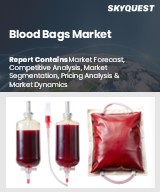
혈액백 세계 시장 규모는 2023년에 4억 3,620만 달러로 평가되었으며, 2024년 4억 6,761만 달러에서 2032년에는 8억 1,553만 달러로 성장하여 예측 기간(2025-2032년) 동안 CAGR 7.2%로 성장할 전망입니다.
세계 혈액백 시장은 헌혈에 대한 인식 증가, 정부 및 NGO 주도의 이니셔티브 증가, 의료 인프라 확대에 힘입어 강력한 성장세를 보이고 있으며, WHO의 "Give Blood and Keep the World Beating"과 같은 캠페인은 전 세계 헌혈을 크게 장려하고 있습니다. 을 크게 장려하고, 안전하고 신뢰할 수 있는 채혈 시스템에 대한 수요를 증가시키고 있습니다. 병원과 혈액은행의 증가, 교통 사고로 인한 외상 사례는 효율적인 수혈 솔루션의 필요성을 더욱 높이고 있습니다. 또한 시장은 오염과 감염을 방지하기 위해 엄격한 규제 기준을 충족하는 고급 일회용 혈액 백으로 전환하는 것을 목격하고 있습니다. 그러나 제조업체들은 대규모 테스트와 인증을 수반하는 복잡한 규제에 대응해야 하는 어려움에 직면해 있으며, 이는 수요 증가에도 불구하고 시장 진입과 운영 효율성에 걸림돌이 될 수 있습니다.
Global Blood Bags Market size was valued at USD 436.2 million in 2023 and is poised to grow from USD 467.61 million in 2024 to USD 815.53 million by 2032, growing at a CAGR of 7.2% during the forecast period (2025-2032).
The Global Blood Bags Market is experiencing robust growth, fueled by rising awareness about blood donation, increased government and NGO-led initiatives, and expanding healthcare infrastructure. Campaigns like WHO's "Give Blood and Keep the World Beating" have significantly encouraged global blood donation, boosting demand for safe and reliable blood collection systems. The growing number of hospitals, blood banks, and trauma cases from road accidents further amplify the need for efficient transfusion solutions. Additionally, the market is witnessing a shift toward advanced disposable blood bags that meet stringent regulatory standards to prevent contamination and infection. However, manufacturers face challenges complying with complex regulations involving extensive testing and certifications, which could hinder market entry and operational efficiency despite the growing demand.
Top-down and bottom-up approaches were used to estimate and validate the size of the Global Blood Bags market and to estimate the size of various other dependent submarkets. The research methodology used to estimate the market size includes the following details: The key players in the market were identified through secondary research, and their market shares in the respective regions were determined through primary and secondary research. This entire procedure includes the study of the annual and financial reports of the top market players and extensive interviews for key insights from industry leaders such as CEOs, VPs, directors, and marketing executives. All percentage shares split, and breakdowns were determined using secondary sources and verified through Primary sources. All possible parameters that affect the markets covered in this research study have been accounted for, viewed in extensive detail, verified through primary research, and analyzed to get the final quantitative and qualitative data.
Global Blood Bags Market Segments Analysis
Global Blood Bags Market is segmented by Product, Volume, Material, Application, End Use and region. Based on Product, the market is segmented into Single Blood Bag, Double Blood Bag, Triple Blood Bag and Others. Based on Volume, the market is segmented into 100ml, 150ml, 250ml, 300ml, 350ml, 400ml, 450ml and 500ml. Based on Material, the market is segmented into PVC, PET and Others. Based on Application, the market is segmented into Collection Blood Bags and Transfer Blood Bags. Based on End Use, the market is segmented into Hospitals & Clinics, Blood Banks and Others. Based on region, the market is segmented into North America, Europe, Asia Pacific, Latin America and Middle East & Africa.
Driver of the Global Blood Bags Market
The Global Blood Bags market is experiencing substantial growth, primarily fueled by the increasing demand for double, triple, quadruple, and penta-blood bags. This surge is attributed to the heightened need for trauma care, oncology treatments, and component-based transfusions and surgeries. Additionally, the market is expanding notably in technologically advanced regions, where advancements in treatment precision enable the effective separation of plasma, red blood cells, and platelets. As healthcare providers seek more efficient solutions to meet patient needs, the demand for diverse blood bag configurations continues to rise, thereby driving the overall market forward.
Restraints in the Global Blood Bags Market
The Global Blood Bags market faces several significant restraints, primarily stemming from heightened manufacturing costs and delays in product approvals, which are a result of stringent government regulations regarding sterility checks, advanced labeling requirements, and the use of DEHP-free materials. Additionally, smaller companies often grapple with entry barriers, particularly when attempting new product launches, which complicates their market strategies and limits their ability to capture market share within the blood bags industry. As a result, these challenges create a complex landscape that hinders growth and innovation in the sector, affecting both established players and newcomers alike.
Market Trends of the Global Blood Bags Market
The Global Blood Bags market is witnessing a significant trend towards the adoption of AI-enabled monitoring systems, particularly in North America and the Asia-Pacific regions, as of early 2024. This innovative approach enhances operational efficiency by providing real-time data on temperature, storage conditions, and logistics of blood bags, thereby reducing human error and improving compliance with health regulations. The shift toward digitized operations aligns with the growing urban demand for reliable blood supply, facilitating better market penetration in densely populated areas. As healthcare facilities continue to prioritize operational efficiency and patient safety, the integration of AI technologies is poised to shape the future landscape of the blood bag market.